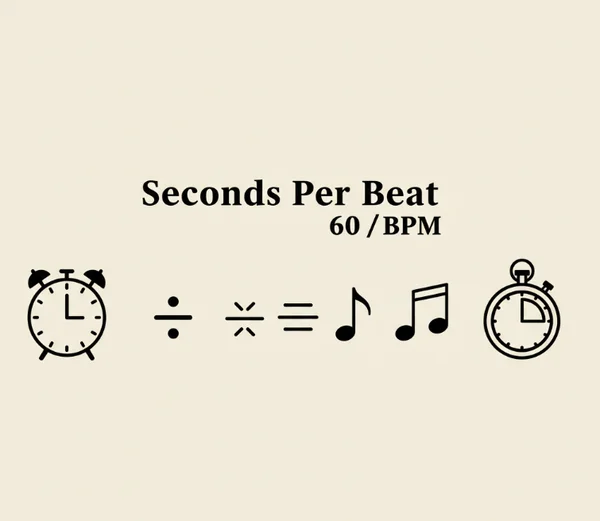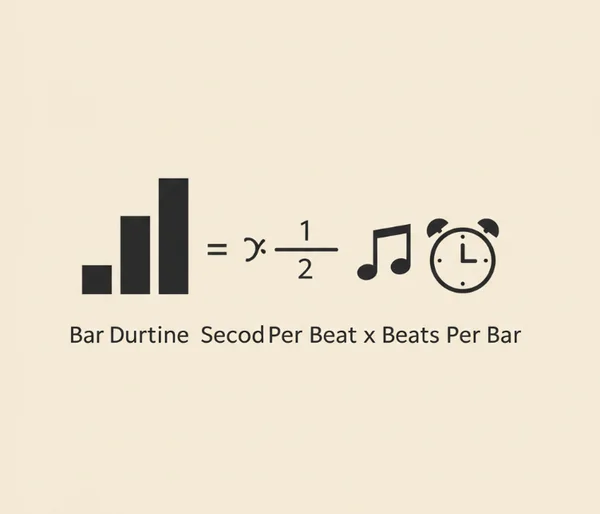Matemática do Metrônomo: BPM para Segundos e Duração da Batida (140 BPM Explicado)
Desbloqueie os Segredos da Temporização: Calcule a Duração da Batida e Mais com a Matemática do Metrônomo! Já se perguntou quanto tempo dura uma batida a 140 BPM? Ou talvez você esteja tentando descobrir a conversão precisa de BPM para segundos para sua última peça musical. Entender essa matemática musical é fundamental para dominar a precisão do seu ritmo. Este guia desmistificará o cálculo da duração da batida e muito mais. Saiba mais sobre cálculos de metrônomo agora!
Por que a Compreensão da Matemática do Metrônomo Importa para os Músicos
Para qualquer músico, do iniciante ao profissional experiente, compreender a relação entre o tempo (muitas vezes expresso em batidas por minuto ou BPM) e o tempo real é fundamental. Não se trata apenas de tocar "no tempo"; trata-se de entender a própria estrutura da estrutura musical. Saber como calcular a duração da batida permite uma prática mais precisa, melhores decisões de arranjo e uma conexão mais profunda com a música que você cria e executa. Se você está definindo efeitos de delay, programando máquinas de bateria ou simplesmente tentando internalizar um ritmo complexo, os cálculos do metrônomo são seus melhores amigos. Esse conhecimento o capacita a assumir o controle de sua prática musical e alcançar maior precisão.
O que exatamente é BPM (Batidas por Minuto)?
Antes de mergulhar nas conversões de BPM para segundos, vamos solidificar nossa compreensão do próprio BPM. O que significa BPM na música?
Compreendendo "Batidas por Minuto"
BPM, ou batidas por minuto, é uma medida padrão de tempo na música. Ele informa exatamente quantas batidas ocorrerão em um período de sessenta segundos. Por exemplo, uma peça a 60 BPM terá 60 batidas em um minuto, o que significa que cada batida dura precisamente um segundo. Um tempo de 120 bpm significa que há 120 batidas em um minuto, então cada batida tem meio segundo de duração. Este número simples é a base para todas as fórmulas de tempo da música.
Por que o BPM é uma Métrica Essencial para o Músico
BPM é uma linguagem universal para músicos. Permite que os compositores comuniquem sua velocidade pretendida, ajuda as bandas a tocar de forma coesa e fornece uma estrutura sólida para a prática musical individual. Se você estiver usando um metrônomo tradicional ou uma ferramenta de metrônomo online versátil, a configuração BPM é seu guia principal para o pulso da música.
A Fórmula Principal: Convertendo BPM para Segundos por Batida
Agora para o cerne da nossa matemática musical: convertendo BPM para a duração real de cada batida em segundos. Qual é a fórmula para BPM para segundos?
A Regra Simples "60 / BPM" para Segundos por Batida
A fórmula para calcular a duração da batida em segundos é notavelmente simples: Segundos por Batida = 60 / BPM
Por que 60? Porque há 60 segundos em um minuto. Dividindo 60 pelo número de batidas por minuto, você descobre exatamente quanto tempo dura uma batida.

Calculando Segundos por Batida a Partir de Qualquer Tempo
Vamos dividir:
- Identifique o BPM da música. Por exemplo, digamos que seja 90 BPM.
- Pegue o número 60 (segundos em um minuto).
- Divida 60 pelo BPM: 60 / 90 = 0,666... segundos. Então, a 90 BPM, cada batida dura aproximadamente 0,67 segundos por batida. Este cálculo de BPM para segundos é essencial.
Casos de Uso Prático para Conhecer Segundos por Batida
Entender segundos por batida tem muitas aplicações:
- Definindo Tempos de Delay/Reverb: Os músicos costumam definir os tempos de decaimento do efeito com base na duração da batida para coesão rítmica.
- Programação de Máquinas de Bateria: A colocação precisa de amostras requer o conhecimento do comprimento preciso de cada batida.
- Sincronização de Vídeo: Os editores precisam alinhar as dicas visuais com as batidas musicais.
- Coreografia de Dança: Cronometrando os movimentos precisamente com a música.
Calculando o Comprimento da Batida: Quanto Tempo Dura uma Batida em Qualquer Tempo?
Embora "segundos por batida" e "comprimento da batida" sejam frequentemente usados indistintamente neste contexto, focar no cálculo do comprimento da batida reforça a ideia de uma duração mensurável.
Definindo o Comprimento da Batida no Tempo Musical
O cálculo do comprimento da batida simplesmente fornece a duração física de uma única batida em unidades de tempo, tipicamente segundos. É o pulso tangível que você sente e toca. Isso é crucial para o desenvolvimento da precisão rítmica.
A Importância do Comprimento Preciso da Batida para a Prática
Conhecer o comprimento exato de uma batida ajuda você a internalizar os ritmos de forma mais eficaz. Quando você pratica com um metrônomo online preciso que fornece um pulso consistente, você está treinando seu relógio interno para reconhecer essas durações precisas. Isso é especialmente importante ao trabalhar em passagens desafiadoras ou tentar atingir um groove específico.
Além de Batidas Únicas: Calculando a Duração do Compasso a Partir do BPM e da Assinatura de Tempo
A música não é apenas uma série de batidas individuais; ela é organizada em compassos (ou medidas). Como a assinatura de tempo afeta o comprimento do compasso?
Como as Assinaturas de Tempo (por exemplo, 4/4, 3/4) Afetam o Comprimento do Compasso
A assinatura de tempo informa duas coisas cruciais:
- O número superior: Quantas batidas há em cada compasso.
- O número inferior: Que tipo de nota recebe uma batida (por exemplo, um 4 significa que uma semínima recebe uma batida).
Para calcular a duração do compasso, o número superior é a chave. Uma assinatura de tempo 4/4 significa que há 4 batidas por compasso. Uma assinatura de tempo 3/4 significa 3 batidas por compasso.

A Fórmula: Duração do Compasso = (Batidas por Compasso × Segundos por Batida)
Para encontrar a duração de um compasso completo, você usa esta fórmula de tempo de música: Duração do Compasso = (Número de Batidas por Compasso) * (Segundos por Batida)
Você primeiro precisa dos segundos por batida do nosso cálculo anterior de BPM para segundos.
Exemplo Prático: Calculando a Duração de um Compasso 4/4
Digamos que nosso tempo seja 120 bpm e a assinatura de tempo seja 4/4.
- Calcule Segundos por Batida: 60 / 120 BPM = 0,5 segundos por batida.
- Identifique Batidas por Compasso: No tempo 4/4, há 4 batidas por compasso.
- Calcule a Duração do Compasso: 4 batidas * 0,5 segundos/batida = 2 segundos por compasso. Então, a 120 bpm no tempo 4/4, cada compasso dura 2 segundos. Uma função de calculadora de duração de compasso pode ser útil para isso.
Ferramentas para Ajudar: Usando Seu Metrônomo Online para Cálculos Rápidos
Embora entender os cálculos do metrônomo seja valioso, você nem sempre precisa fazer a matemática musical manualmente. Quais são os usos práticos para saber o comprimento da batida se uma ferramenta pode ajudar?
Aproveitando Nosso Metrônomo Online para Tempo e Temporização
Ferramentas modernas como nosso metrônomo online gratuito podem fornecer instantaneamente uma batida estável em qualquer BPM desejado. Embora possa não exibir os segundos por batida diretamente, definir o BPM é o primeiro passo. Alguns metrônomos digitais avançados ou estações de trabalho de áudio digital (DAWs) podem até mostrar essas conversões de tempo.

Usando Metrônomos Digitais para Verificar Seus Cálculos Manuais
Você pode usar um metrônomo online confiável para ter uma ideia do tempo depois de ter feito seu cálculo de BPM para segundos ou comprimento da batida. Se você calcular que 140 bpm significa que cada batida é pouco menos de meio segundo, ouvir um metrônomo a 140 bpm confirmará isso tacitamente, ajudando você a internalizar a precisão do ritmo. É uma ótima maneira de verificar sua compreensão da matemática de tempo.
Dominando a Matemática do Metrônomo para Musicalidade Aprimorada
Entender a relação entre BPM, segundos por batida, cálculo do comprimento da batida e duração do compasso – os fundamentos da matemática do metrônomo – o capacita como músico. Ele o move além de simplesmente "sentir" o tempo para um engajamento mais preciso e consciente com o tempo musical.
Fórmulas e Conclusões Chave
- Segundos por Batida: 60 / BPM
- Duração do Compasso: (Batidas por Compasso) * (Segundos por Batida) Essas fórmulas simples de tempo de música são ferramentas poderosas. Lembre-se de que um tempo como 140 bpm tem um comprimento de batida específico e mensurável, e saber isso pode melhorar significativamente sua prática e composições musicais.
Perguntas Frequentes sobre Cálculos de BPM e Tempo
Como calculo o comprimento da música a partir do BPM e do número de compassos?
Para calcular o comprimento total de uma música, você primeiro precisa calcular a duração de um compasso (como mostrado acima: Duração do Compasso = (Batidas por Compasso) * (60 / BPM)). Em seguida, multiplique a duração do compasso pelo número total de compassos na música: Comprimento da Música = Duração do Compasso * Número de Compassos. Isso pode ser muito útil para planejar apresentações ou gravações.
Qual é o método mais fácil para converter milissegundos (ms) em BPM?
Se você souber a duração de uma batida em milissegundos (ms), a fórmula para converter para BPM é: BPM = 60000 / Duração_em_ms. Por exemplo, se uma batida tem 500ms de duração: BPM = 60000 / 500 = 120 BPM.
Seu metrônomo online pode mostrar o comprimento da batida diretamente?
Atualmente, nosso metrônomo online neste site se concentra em fornecer um clique BPM preciso. Embora não exiba explicitamente o cálculo do comprimento da batida em segundos, você pode usar as fórmulas discutidas neste artigo para determiná-lo facilmente a partir do BPM que você definir em nossa ferramenta.
O que significa 140 BPM na música?
140 BPM significando na música indica um tempo relativamente rápido, com 140 batidas ocorrendo a cada minuto. Como calculamos, cada batida a 140 BPM dura aproximadamente 0,429 segundos. Este tempo é comum em gêneros enérgicos como trance, pop rápido e algumas formas de rock e metal. Entender este cálculo específico do comprimento da batida ajuda os músicos a tocar com energia e precisão adequadas.
Qual é a fórmula para BPM para segundos?
A fórmula fundamental para converter BPM para segundos (especificamente, segundos por batida) é: Segundos por Batida = 60 / BPM. Esta é uma pedra angular da matemática musical e essencial para qualquer cálculo de comprimento de batida ou fórmula de tempo de música. Por que não experimentar nosso metrônomo online agora para praticar com diferentes BPMs?